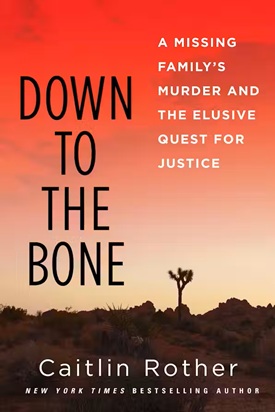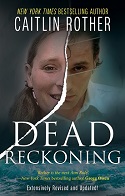 Synopsis:
Synopsis:
It was as if time had stopped for the Southern California family of four who mysteriously vanished without a trace.
On February 15, 2010, Joseph McStay, his wife Summer, and their two young sons were reported missing from their new home in San Diego County by Joseph’s brother, Michael. They left eggs and fruit rotting on the counter. Their Dodge truck sat in the driveway. Their dogs were abandoned outside without food or water. But investigators found no blood, signs of a struggle, or clues to their whereabouts.
Did the family take an unannounced vacation? Were they running away from personal problems? Or were they victims of foul play?
Nearly four years later, a motorcyclist found the McStays’ remains in and around two shallow graves in the Mojave Desert, one hundred miles from their home. Their skulls showed signs of blunt-force trauma, perhaps inflicted by the sledgehammer buried with them.
Authorities focused on Charles “Chase” Merritt, a close friend and subcontractor for Joseph’s company. Despite a lack of physical evidence, scenarios that defied logic, and numerous unanswered questions, prosecutors convinced a jury of Merritt’s guilt. After an emotional sentencing hearing, the judge imposed the death penalty.
But did another possible suspect, who was ignored by investigators and ducked a subpoena to testify, get away with murder?
Following her signature meticulous and extensive research, bestselling author and investigative reporter Caitlin Rother hunts for the truth behind a heinous crime that became a nation’s obsession, with a controversial trial in its wake . . . and lingering questions of justice.
Review:

For investigative journalist and bestselling author Caitlin Rother, publication of Down to the Bone was a personal victory achieved following extraordinary effort on her part to tell the story of the brutal and mystifying murders of a young family. Specifically, she spent twelve years researching and writing the book and publication was delayed three times before it finally made its way into bookstores and the hands of eager readers.
Rother began following the case from the very beginning when she saw news reports about the disappearance of the McStay family. She notes that every day in the United States an average of 600,000 people – usually a single child or adult – go missing. However, it is extremely “rare for a family of four, especially with two young children” to simply vanish. But that’s what happened sometime prior to February 15, 2010, in San Diego County.
Eleven days of no contact elapsed before Michael McStay alerted the San Diego County Sheriff’s Department that his brother, Joseph, and Joseph’s wife, Summer, as well as their two sons, aged three and four, were unaccounted for. The deputy who responded to the McStay’s home testified, “It appeared that whoever was there, in my mind, had just got up and left.” Although the front door was locked, the family’s truck was parked in the driveway with a newspaper dated February 5, 2010, lodged under one of the tires. In the kitchen, food, dirty dishes, and Summer’s prescription glasses were left on the counters, and mold was floating in the coffee pot. It appeared that someone had been interrupted while painting the kitchen without an opportunity to clean up because doors and drawers were laid out on newspaper on the floor, and a roller was caked with dried paint and stuck to the tray into which paint had been poured. The family’s two dogs were abandoned in the backyard of the residence with no food or water. Because the McStays were in the process of remodeling the house, it was impossible to discern whether other areas were equally unkempt because of the ongoing renovation or if the family routinely maintained the home in that manner.
Investigators found no blood or any signs of a struggle in or around the home. They discovered no evidence pointing to why the McStays seemingly left their residence abruptly and unexpectedly. There were no clues left behind as to their whereabouts, whether someone else was involved in their disappearance and, if so, the identity of that person or persons.
From its inception, the case was mishandled by law enforcement. Since the San Diego Sheriff’s Department had no missing persons team, the responding deputy referred the matter to homicide detectives who also immediately recognized that something was very wrong. They began conducting interviews, asking detailed questions about the McStays and their relationships with family members and business associates, and delving into the McStays’ finances. They also issued a news release concerning the McStays’ disappearance.
But they failed to secure the McStay residence as a possible crime scene. Joseph’s mother, Susan, proceeded to the home, gained access, and commenced cleaning the kitchen, potentially destroying evidence in the process. Four days later, investigators, who were in the process of obtaining a search warrant, returned to the scene to find it permanently and irretrievably altered. Susan insisted she had been given permission to clean up, a claim detectives denied. But at that juncture the detectives were viewing the matter as a missing persons case, not an active homicide investigation, so they didn’t feel they “could tell the McStays what to do or not to do, especially when they didn’t believe Joseph’s family had been murdered.”
Joseph owned and operated a waterfall manufacturing business which lacked formal structure. Apparently, sans any written agreements outlining each party’s duties and responsibilities, Joseph had two business associates. Charles “Chase” Merritt worked on installation of the projects Joseph designed, while Dan Kavanaugh created and maintained the company website. Joseph was increasingly pursuing custom projects with Merritt which they considered separate and apart from the main business, maintaining separate financial records documenting their efforts. Joseph had become embroiled in a dispute with Kavanaugh, known as “Hacker Dan” and “Dan the Hacker,” that resulted in Kavanaugh threatening in January 2009 to disable the business website and destroy the business. Joseph felt he had no choice but to capitulate to Kavanaugh’s demands that Joseph buy him out of what he asserted was his share of the business. Kavanaugh made those threats in writing via instant messages. But mentioned none of those details when he contacted the authorities on February 10, 2010, concerning his inability to reach Joseph or posted on Facebook a day earlier that Joseph was “AWOL.” Investigators failed to deem that information relevant. As far as Michael knew, Kavanaugh had been paid in full for any ownership interest he’d had in the business and when the McStays disappeared, he was merely “contract labor” paid on a monthly basis “to do the internet stuff.”
Merritt insisted that he had a good working relationship with Joseph and they communicated regularly about various projects, having never had any kind of falling out. He maintained that he had no motive to harm the McStays, in part because “without Joseph, ‘my business is done. I mean my/our entire business.’” Merritt acknowledged he lacked the ability to perform the tasks Joseph did, such as creating drawings and dealing with customers. He denied ever meeting Kavanaugh, whom Joseph feared following their disagreement the previous year. “Joseph talked about that all the time. Joseph was always afraid that [Kavanaugh] was just going to push a button and the website would be gone because that is what Dan said when they clashed.” Allegedly, Kavanaugh told Joseph, “I’m not a person that you want to piss off on the web.” Merritt agreed to provide a DNA sample in order to be ruled out as a possible suspect, but authorities failed to follow up.
The McStays’ whereabouts and fate remained an unsolved mystery for nearly four years until an off-road motorcyclist noticed what appeared to be a human skull in the Mojave Desert. Authorities found more child-sized bones strewn about and two shallow graves with tire tracks from two different large vehicles leading up to them. (Ironically, Michael told a newspaper in March 2010 that he feared he was “looking for two adult shallow graves and . . . my two nephews’ crosses,” accurately describing what was eventually found.) Among the other items retrieved from the gravesites was a sledgehammer, and three of the four family members were determined to have died as a result of blunt-force trauma to the head. Notably, the size of the head wounds matched the sledgehammer. Head wounds generally result in heavy blood loss, but there was no blood or DNA retrieved.
Rother is known for her painstaking research, but Down to the Bone required Herculean efforts to gather and assimilate the evidence and distill it into a manageable and engrossing narrative that both holds readers’ interest and accurately portrays the case’s convoluted and disturbing route to a controversial and questionable verdict.
Rother reviewed thousands of pages of documents, including search warrants, affidavits, public records, and transcripts. She attended or watched portions of the trial and conducted interviews of the few people who would cooperate with her. After she had completed a manuscript of about 90,000 words with four months to go until her submission deadline, she received thousands more pages of discovery materials that had never before been released to the public from two sheriff’s agencies. She began the arduous task of digesting that information and revising the book.
Who murdered the McStay family? More importantly, what could serve as motivation to kill two innocent little boys, only three and four years old, along with their parents, especially in such a heinous manner?
Rother spent years working as a respected investigative journalist before becoming a true crime author. She still employs her investigative skills, but even though she is no longer employed by a news organization as a reporter and, technically, not constrained by the principles governing that profession, she continues to resolutely refrain from offering an opinion about the cases she researches. Rather than take a position on anyone’s guilt or innocence, Rother says, “I’m just the messenger, laying out the evidence and the sometimes-ugly truth of how this case came together.” Still, she admits, “I honestly don’t know who killed the McStays.”
Rother’s straight-forward, easy to follow but deeply disturbing narrative details an exceedingly complicated case that was mismanaged from the outset. She illustrates the investigators’ confirmation bias that caused them to overlook crucial evidence and fail to follow leads that might have led them to logical conclusions. The assigned judge was guilty of the same prejudiced view of the matter, failing to issue a search warrant as the investigation was just getting underway, despite there being sufficient probable cause to do so. That same judge exhibited no ability to manage his courtroom or the proceeding, allowing the attorneys to turn the trial into an undisciplined spectacle. He issued arguably erroneous evidentiary rulings, and finally just gave up, ceding control to highly unprofessional attorneys and leaving it to a higher court to review the record and render correct findings.
Rother compellingly details the prosecution’s construction and presentation to the jury of a timeline describing how the murders occurred that defied logic since it was “completely full of holes, discrepancies, and conflicts.” Rother approaches every case with an open mind but acknowledges that “the more I got into this, the more I could see that was true.” Expert witnesses can be particularly problematic, and in this case, one expert was fired solely because his opinion did not fit the narrative concocted by counsel, and another expert was substituted and permitted to testify even though his theory and conclusions were insupportable.
Merritt was convicted of four counts of first-degree murder with special circumstances (multiple murders), and the jury imposed the death penalty for the killing of Summer and the children, and sentenced him to life without the possibility of parole for Joseph’s murder.
Unbelievably, the jury convicted Merritt without ever hearing evidence about when, where, how, or why the McStays were killed.
As noted, there was no blood found in their home, vehicles, the gravesites, on the sledgehammer buried with them or the clothing they were apparently wearing when they were buried, or in Merritt’s vehicle. The prosecution contended that Merritt’s vehicle was at the McStay residence, despite competent contradictory evidence establishing that the vehicle seen on video footage definitely was not Merritt’s. Merritt was shown to be a thief and gambler but had no history of violence. He forged checks totaling approximately $20,000 so the prosecution asked the jury to believe that served as sufficient motivation to murder the family of four in their residence by smashing their skulls with a sledgehammer before transporting their bodies to the desert where they were buried (despite no blood or DNA being found anywhere). The cell phone evidence proffered by the prosecution was not just muddled and confusing. It lacked scientific support and failed to establish Merritt’s presence in specific locations at the precise times the prosecution argued established his guilt – even though no time of death was ever determined.
The judge precluded the defense from relying upon a third-party culpability theory, citing no direct connection to Kavanaugh, even though the dispute between him and Joseph was shown, along with Kavanaugh’s threats to destroy the business. Financial records proved that Kavanaugh extracted more than $200,000 from the business and spent all but $59,000 of that sum in nightclubs, etc. He engaged in other machinations, some before the McStay family went missing, including taking over the business account, changing the password, and claiming to be the owner in an attempt to sell the business to two men who owned a marijuana dispensary. A gun belonging to Joseph was found in an abandoned vehicle in Las Vegas and traced back to a man who owned a dispensary. Moreover, Kavanaugh had a history of threatening women as well as a potential male client, telling him his bones could turn up in the desert “like the other people who had gone against him in business deals.” Allegedly, Kavanaugh bragged about killing the McStays. Nonetheless, the judge refused to admit evidence pertaining to Kavanaugh’s character or criminal record, or his threats to Joseph.
Merritt maintains he had inadequate representation, a claim that will undoubtedly be explored by the appellate court. He attempted to represent himself, dismissed several attorneys, and one lawyer conflicted out of the case after he failed to present complex exculpatory evidence pertaining to cell phones and how their locations are determined.
Now sixty-eight years old, Chase Merritt remains imprisoned in California, pending the outcome of the automatic appeal triggered by imposition of the death penalty. Such appeals typically span between ten and twenty years.
Rother says it is her hope that reading Down to the Bone will enlighten readers about “the workings and flaws of our criminal justice system and also changes preconceived notions” about the McStay case in particular. In Down to the Bone she reveals how multiple failures and mistakes shed serious doubt on whether the McStay family’s killer was convicted . . . or remains at large. She masterfully lays out the salient aspects of the investigation and trial and, in the process, elucidates the numerous ways in which the criminal justice system buckled under the weight of incompetence, callous disregard, biases, and egos. Did prosecutorial misconduct, fueled by a desire to win at any cost, result in the conviction of an innocent man? That’s an issue with which the appellate court will certainly grapple.
Done to the Bone is as fascinating as it is disappointing and disturbing, but Rother deftly guides readers on a difficult journey, compelling them to reach their own conclusions about whether justice has been served. It’s a question readers will likely ponder again and again.



















Comments are closed.